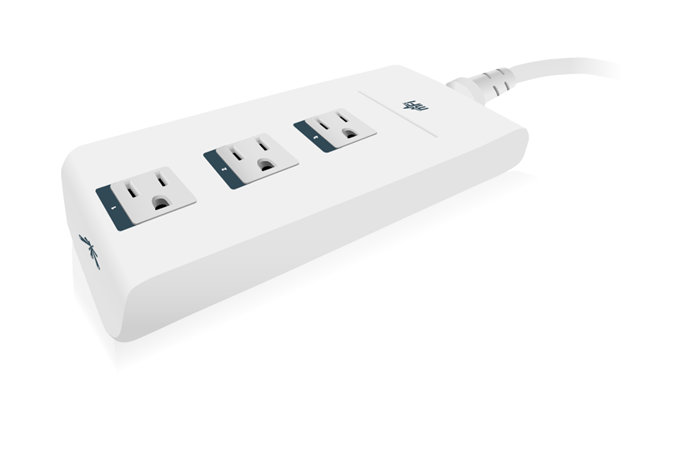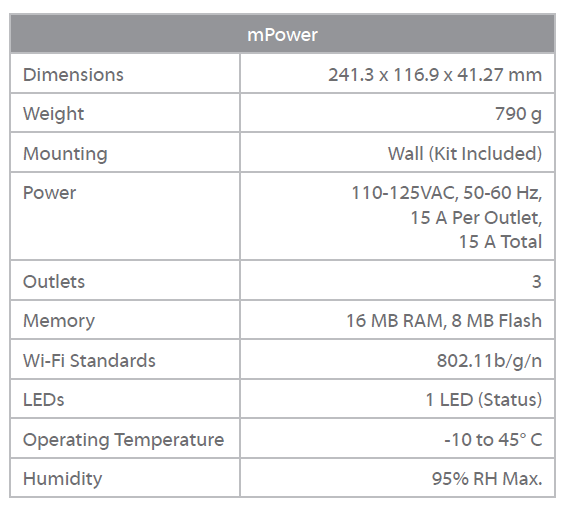Ubiquiti Networks mFi mPower Wi-Fi Power Strip Review
by Ganesh T S on November 21, 2013 3:00 AM EST- Posted in
- Home Automation
- Wi-Fi
- Ubiquiti Networks
- IoT

Introduction
The Internet of Things (IoT) revolution is happening right now. As smartphones proliferate, consumers want the ability to control devices in an automated and easy manner. Remotely switching a power outlet is one of the basic building blocks of an automation system (home or business building). Last year, we reviewed Visible Energy's UFO Power Center, a standalone device which combined energy awareness and home automation in a striking package. Today, we are looking at Ubiquiti's mPower mFi power strip. This is a device with similar features (ability to turn on/off an outlet over a wireless network and measure the power consumed by a device connected to an outlet). However, it caters to a very different market segment.
Ubiquiti Networks - Background
Ubiquiti Networks started off as a manufacturer of wireless products for enterprises, aiming mainly at emerging markets. We have generally found that their kits cost much lower than the competition (and it is attributed mainly to the fact that they don't employ a dedicated sales / marketing team). A couple of years ago, Ubiquiti started looking into expanding their product portfolio. One of the under-served product categories amongst businesses (Ubiquiti's target customers) is that of building automation. As home automation picks up steam, building automation (a term that I will use to talk about home automation technologies from the perspective of an office building) can be expected to follow. Ubiquiti launched the mFi product category to catch this wave. Ubiquiti calls the mFi as the reinvention of machine-to-machine (M2M) communication.
mFi - A Platform for Building Automation
The mFi product category consists of three main products, the mPort, mPort Serial and mPower. A number of sensors (under the mSensor category) are also included, and these interface with the mPort units through a Cat 5 cable. These include door sensors, motion detectors (both wall and ceiling varieties), temperature and current sensors. The mPort Serial provides a remote serial connection for any other devices controllable through a serial interface. Control of multiple such devices is integrated in a management software called mFi. Written in Java, it is compatible with multiple platforms.
Introducing the mPower
The product we are going to cover in detail today is the mPower. It comes in three variants, all of which support connection to a Wi-Fi network. The fundamental difference is in the number of switchable outlets. The mPower Mini has one, the mPower has three and the mPower Pro has eight. The mPower Pro also has a wired network port. Simply put, the mPower units allow the outlets to be turned on / off over the network using the mFi management software as well as a web interface. Essential statistics about each outlet (VRMS, IRMS, power factor and active power) are also reported through both avenues.
The mPower retails for around $60. The mFi controller software is bundled free with the unit. The mPower Pro (8-outlet version) retails for around $100, which represents better value per outlet. However, the Pro units were not easy to source since Ubiquiti had some supply constraints. Ubiquiti's products are not present in the usual retail channels. Instead, they are sold by B2B vendors (who sometimes have a presence on Amazon). The specifications of the mPower, as provided by Ubiquiti, are presented in the table below.

In the remainder of this piece, we will look at the setup and usage impressions, followed by details of the mPower platform. We will also present one of our custom applications developed for the mPower, thanks to its open platform. This will be followed by a few concluding remarks summarizing the pros and cons of the unit.










61 Comments
View All Comments
dac7nco - Friday, November 22, 2013 - link
Oh; these UPS systems manage a fair job of power consumation; it's why they sell so well. 2,500+ 4/5/9U UPS had better be measuring it's own power! Most of these will tell you re: power-draw from their peripheral AC ports. Things like printers should be on non-UPS AC ports; I have a (small) 12U rack, with a 4U desktop, a 2U Co-processor for offline jobs, a 4U storage/NAS system and a 2U cyberpower 1,650-Watt UPS. This Cyberpower UPS will run these things for about 2-hours.ganeshts - Friday, November 22, 2013 - link
Can you link me to this exact Cyberpower model which can tell the power draw on the peripheral AC ports ?dac7nco - Friday, November 22, 2013 - link
http://www.cyberpowersystems.com/products/ups-syst...dac7nco - Friday, November 22, 2013 - link
http://cdn4.tinkertry.com/wp-content/uploads/2012/...Jaybus - Tuesday, November 26, 2013 - link
These UPSs monitor individual outlets and can be controlled via Ethernet, serial, or USB, but afaik they cannot switch individual outlets. They power on or off all outlets simultaneously. To get individually switched outlets requires a switched PDU, which is substantially more cost. The mPower can work as a much cheaper PDU.processinfo - Friday, November 22, 2013 - link
How much power it is using by itself?ganeshts - Sunday, November 24, 2013 - link
Around 1 W with things at idle, but the network interface up.CBRworm - Friday, November 22, 2013 - link
I think devices like this are great, certainly an emerging market which I appreciate being reviewed. I have been using ubiquiti devices for many years and have found them to be mostly solid hardware with software that may be lacking.I would like to get my hands on a few of these to play with, currently I also use Kill-A-Watts to measure power consumption and the only power control devices are things I hacked together being driven through a parallel port. These devices would be great for me to turn off devices in other areas of the house - like the upstairs TV and/or Xbox at dinner/bed time. Christmas lights and other lights around the house would also be good. I love being able to turn the thermostats up and down from my phone - this would be a great extension of that.
As for the UPS's. The batteries for my UPS's are in line with the cost of the Pro device. While the UPS is useful for helping with some management features on computer hardware, 90% of the uses for this device would not be well suited by a UPS with management packages.
mhammett - Friday, November 22, 2013 - link
A couple things...1) UBNT's history has not been the enterprise space, but in the service provider market. The bulk of their revenue still comes from service providers.
2) The mFi line is targeted towards building automation, not standard consumer home automation.
3) mFi is a whole line of products, not just this device. That said, they still don't have the devices that I am looking for.
4) I don't know if you can run the devices without the controller software, but why would you want to? The software is the best part of the whole thing. You have dozens of these devices and have scripts on the server that read the data that the system collects and can make decisions based upon them.
5) I was a beta tester for mFi, though I don't have a history with building automation systems. In my testing, it has been a good system. It will be a great system when they release the deices I asked for. ;-)
ganeshts - Friday, November 22, 2013 - link
Thanks for your thoughts. Can you let me know what devices you are looking for? I am pretty sure a mFi Thermostat would be well received.. Just wondering what else people want out there.Yes, you can run the devices without the controller software. For our usecase, we don't want the hassle of running a VM or server hosting the mFi controller -- just need the ability to turn on and off an outlet and do real-time power measurement on the outlets. Yes, if you need the rules, you should use the mFi controller -- but, if they are simple, they could be handled by scripts running on a PC or even on the mPower itself (in certain cases).